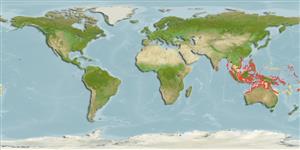>
Holocentriformes (Squirrelfishes, soldierfishes) >
Holocentridae (Squirrelfishes, soldierfishes) > Holocentrinae
Etymology: Sargocentron: Greek, sargos = sargus + Greek, kentron = sting (Ref. 45335).
More on author: Bleeker.
Environment: milieu / climate zone / depth range / distribution range
Ecologia
marino; salmastro associati a barriera corallina; distribuzione batimetrica 6 - 40 m (Ref. 90102). Tropical; 20°N - 25°S
Western Pacific: Indonesia (including Mentawai Islands), Philippines, Solomon Islands, and Great Barrier Reef. Also reported from Malaysia (Ref. 5756), Tosa Bay, Japan (Ref. 559), and Viet Nam (Ref. 9706).
Size / Peso / Age
Maturity: Lm ? range ? - ? cm
Max length : 27.0 cm TL maschio/sesso non determinato; (Ref. 48635); peso massimo pubblicato: 92.90 g (Ref. 124708)
Spine dorsali (totale): 11; Raggi dorsali molli (totale): 12-13; Spine anali 4; Raggi anali molli: 9. This species is distinguished by the following characters: 3rd or 4th dorsal spines longest, 1.8-2.0 HL; pectoral rays 13-14 (usually 13); lateral line scales 33-38, scale rows above 2.5; oblique scale rows on cheek 4; gill rakers of first gill arch 5-7 + 9-11; body depth 2.7-3.0 in SL; posterior edge of nasal fossa with 1-6 spinules, 0-1 at anterior edge; upper edge of first suborbital bone with a laterally projecting spine near a vertical at the front edge of orbit, followed by a serrated ridge; preopercular spine 3/4 to nearly equal to orbit diameter, 2.85-3.5 in head length. Colour of body with alternating broad deep red and narrow silvery stripes on body; distinct black spot on middle of caudal-fin base; black marks at base of soft dorsal and anal fins; dark streak near anterior edge of anal fin (Ref. 27370, 90102).
Inhabits coral-rich areas of outer reef slopes and drop-offs to depths greater than 40 m (Ref. 9710). Hides in caves or beneath ledges by day; forage for food at night, mainly on benthic crabs and shrimps. Spine of preopercle venomous.
Life cycle and mating behavior
Maturità | Riproduzione | Deposizione | Uova | Fecundity | Larve
Randall, J.E., 1998. Revision of the Indo-Pacific squirrelfishes (Beryciformes: Holocentridae: Holocentrinae) of the genus Sargocentron, with descriptions of four new species. Indo-Pac. Fish. (27):105 p. (Ref. 27370)
IUCN Red List Status (Ref. 130435)
Human uses
Informazioni ulteriori
Nomi ComuniSinonimiMetabolismoPredatoriEcotossicologiaRiproduzioneMaturitàDeposizioneSpawning aggregationFecundityUovaEgg development
BibliografiaAcquacolturaProfilo di acquacolturaVarietàGeneticaElectrophoresesEreditarietàMalattieElaborazioneNutrientsMass conversion
Strumenti
Special reports
Download XML
Fonti Internet
Estimates based on models
Preferred temperature (Ref.
123201): 26.5 - 29, mean 28.2 °C (based on 436 cells).
Phylogenetic diversity index (Ref.
82804): PD
50 = 0.5000 [Uniqueness, from 0.5 = low to 2.0 = high].
Bayesian length-weight: a=0.01622 (0.00774 - 0.03400), b=2.97 (2.80 - 3.14), in cm total length, based on LWR estimates for this Genus-body shape (Ref.
93245).
Trophic level (Ref.
69278): 3.6 ±0.59 se; based on food items.
Resilienza (Ref.
120179): Alto, tempo minimo di raddoppiamento della popolazione meno di 15 mesi (Preliminary K or Fecundity.).
Fishing Vulnerability (Ref.
59153): Low vulnerability (17 of 100).
Nutrients (Ref.
124155): Calcium = 52.8 [20.5, 194.2] mg/100g; Iron = 0.474 [0.189, 1.449] mg/100g; Protein = 18.9 [17.8, 20.0] %; Omega3 = 0.157 [0.069, 0.362] g/100g; Selenium = 29.9 [17.5, 56.2] μg/100g; VitaminA = 70.9 [24.5, 203.4] μg/100g; Zinc = 2.06 [0.87, 3.90] mg/100g (wet weight);
